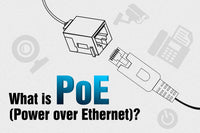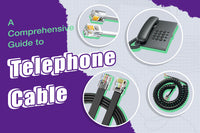Traditional phone calls cannot meet the requirements of growing businesses Individuals or businesses use other methods to communicate with each other, such as emails, social apps, and videos. As technology advances, it’s essential for many businesses to switch from an outdated landline to an internet-based VoIP telephony system. Some people may be confused about VoIP and SIP, but they are in fact different things. VoIP is a broad term and SIP refers to a protocol. Understanding their pros and cons, along with their differences can help you make the right choice for your own business.
What is VoIP?
What is VoIP? VoIP is an acronym for “Voice over Internet Protocol”. It is also known as IP telephone and internet telephone. VoIP enables voice communication over the internet instead of the telephone line or Public Switched Telephone Network (PSTN).
In a VoIP system, the phone is connected to users’ switches or routers. When a user makes a phone call, the voice is converted into digital data packets and sent over the internet, and then these data packets are translated into audio signals back to the receiver.
As a cost-effective alternative to the traditional phone system, VoIP makes it an applicable option for business communications such as instant messaging and conference calling.
Non-hosted vs. Hosted VoIP
In most cases, there are two VoIP setups: non-hosted VoIP or hosted VoIP.
- Non-hosted VoIP: Non-hosted VoIP, also called On-premise VoIP, is located directly in the company. The non-hosted VoIP system allows companies to customize their own requirements but they need to maintain the system independently and hire professional IT persons to ensure optimal services. Private Branch Exchange (PBX) is often used in non-hosted systems to facilitate internal connections by using extensions. Non-hosted VoIP systems are very suitable for large businesses that want to control their infrastructure.
- Hosted VoIP: Hosted VoIP is a cloud-based system that entrusts a third-party VoIP provider to build and maintain the telephony infrastructure, using their servers, hardware, and software. Hosted VoIP is ideal for small businesses as it significantly reduces cost and minimizes the effort for setup and maintenance.
What is SIP?
SIP stands for Session initiation protocol used for multimedia communications. SIP is a critical component of the VoIP system, which can start, keep, and end multimedia communications from one point to other points. The SIP enables voice, video, instant messaging, texting, and other multimedia communications.
SIP works by delivering data packets between different endpoints known as SIP addresses (devices such as smartphones, tablets, and computers). SIP addresses are used to identify the users’ network location. SIP is beneficial to voice and video communications by the IP session. For example, when the first person makes a call, they initiate an invitation. The invite is then sent to another person through proxy servers, who uses an SIP phone.

Note: SIP Line vs. SIP Trunk
The SIP trunk is a virtual communication medium connecting PBX or PABX to the VoIP provider. A SIP trunk holds multiple SIP lines within an entire phone system.
A SIP line controls an individual phone or device via a single phone line. It acts as the single channel connected to the larger SIP trunk and only allows one device to initiate and terminate VoIP calls between two points. The number of SIP lines in the SIP trunk depends on the customers’ specific needs.
SIP Trunking vs. VoIP: What Are Differences?
Some people may think SIP and VoIP are interchangeable. Actually, these two terms are two things, and comparing them does not make much sense.
VoIP is a generalized term referring to any technology that allows a voice signal to transmit over the internet, while SIP is a popular signaling protocol for supporting most types of VoIP communications. VoIP acts as a primary performer and SIP as a crucial supporting assistant. Though VoIP can work independently without SIP, integrating SIP often enhances SIP performance.
Should you choose VoIP-only or VoIP with SIP? we’ll further explore it in the following sections.
VoIP-only vs. VoIP With SIP
VoIP-only Pros and Cons
Pros of VoIP-only
- Cost-effective;
- Easy installation and maintenance;
- Generally does not require long-term service contracts;
- It also features some advanced services such as voicemail, text messaging, routing, and so on;
- VoIP system doesn’t require on-site installation.
Cons of VoIP-only
- VoIP-only requires a reliable internet connection and sufficient bandwidth for quality service;
- Lacks the capability to handle multimedia communications;
- Some basic VoIP services may not support mobile integration or third-party applications;
- VoIP may lead to potential security issues.
VoIP With SIP Pros and Cons
VoIP With SIP Pros
- VoIP with SIP service is an integrated option for multimedia communications that supports voice, video, messaging, conferencing, mobility, and more;
- Can be easily integrated with communications-related collaboration applications and software systems for improved productivity and reduced cost;
- Can provide data recovery for mobile devices in case of network issues;
- Provides integration with existing PRI lines;
- Can be more flexible;
VoIP With SIP Cons
- VoIP with SIP service may need high bandwidth to ensure communication quality;
- The cost and quality of VoIP integrated with SIP by different providers can vary;
- May cause security issues due to the use of the public internet.
VoIP vs. SIP: Which to Choose for Your Business?
Understanding the pros and cons of VoIP and VoIP with SIP can help you better determine which option is the best fit for your business.
In general, VoIP is ideal for businesses seeking voice-only communications over the internet, especially those who don’t have an existing PBX system. VoIP equipped with SIP capabilities allows employees to exchange voices, videos, files, and other forms of data. SIP enables VoIP to integrate with various applications and helps VoIP reduce the burden on calling traffic. For large businesses and enterprises, VoIP with SIP is recommended as it is a united communications solution for enhanced productivity and reduced cost.
Final Thoughts
VoIP systems are typically installed using Ethernet or fiber optic cables. You need to choose Ethernet cables with PoE (Power over Ethernet) technology for high-quality communication. In addition, VoIP and SIP are correlated and can be united to provide a robust communication solution for your business. VoIP with SIP can be a reliable, efficient, and scalable choice.
FAQs
1. Should I choose VoIP or SIP for business?
VoIP with SIP is a better solution for multimedia communications, which supports voice, text, video, mobility, conferencing, and more.
2. Are SIP and VoIP the same?
They can sometimes be interchangeable. But VoIP refers to a broader term for voice communication over the internet while SIP is a protocol that enables VoIP to implement multimedia communications.
3. What is the difference between PRI and SIP trunk?
A Primary Rate Interface system, also known as a PRI trunk, provides a physical connection to the digital PSTN through a PRI circuit, allowing for 23 simultaneous voice channels over a copper wire, In contrast, a SIP trunk offers a virtual connection to the PSTN through a network, supporting many voice and data channels over an existing Ethernet or fiber connection.
For more information on this topic, you can keep up on our blogs. While VCELINK offers general and basic information for our customers and other visitors to the website, it’s not professional advice.



Be the first one to comment.
Leave a comment